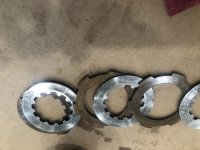Hi guys
It's been a while since I've been on here. And if this question is in the wrong area I apologize. So I have a Lagun Turnmaster 15".
It has a matrix clutch buried deep inside the head stock. Since owning the lathe the clutch will not support using the two highest speed settings. The chuck will never get up to speed but seems to work fine using the other speed options. I looked into buying a new clutch and was given a quote of almost $4000. I removed the clutch a few years ago and examined it, cleaned it up and rearranged the plates hoping it would help. It did help with forward but took away from reverse. I did and know how to adjust the clutch through the inspection plate on the back of the headstock but nothing gets it to the point of where it should be. So I removed it again this morning and looked at it again. The plates are copper and steel from what I can tell with them alternating in the pack. Copper, steel, copper, steel etc... There is no pattern on either of the plates telling me there was any different material that was there and just worn away. The plates do not looked burned and are quite smooth. So how the heck do these grab each other. This may sound stupid but I was thinking on scuffing the plates up with sand paper thinking that may help. Does anyone have any knowledge of this type of clutch? What should the plates look like?



It's been a while since I've been on here. And if this question is in the wrong area I apologize. So I have a Lagun Turnmaster 15".
It has a matrix clutch buried deep inside the head stock. Since owning the lathe the clutch will not support using the two highest speed settings. The chuck will never get up to speed but seems to work fine using the other speed options. I looked into buying a new clutch and was given a quote of almost $4000. I removed the clutch a few years ago and examined it, cleaned it up and rearranged the plates hoping it would help. It did help with forward but took away from reverse. I did and know how to adjust the clutch through the inspection plate on the back of the headstock but nothing gets it to the point of where it should be. So I removed it again this morning and looked at it again. The plates are copper and steel from what I can tell with them alternating in the pack. Copper, steel, copper, steel etc... There is no pattern on either of the plates telling me there was any different material that was there and just worn away. The plates do not looked burned and are quite smooth. So how the heck do these grab each other. This may sound stupid but I was thinking on scuffing the plates up with sand paper thinking that may help. Does anyone have any knowledge of this type of clutch? What should the plates look like?







